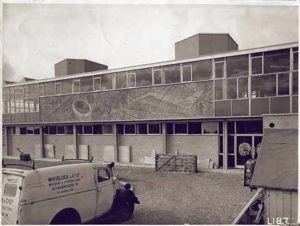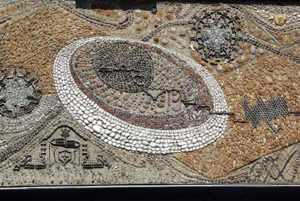A fascinating meeting of art & industry
Sylvia Antonsen tells the story of a 1950s Dorset factory project
Published in November ’17
In 1938 Ludwig Loewy, a German Jewish engineer, in fear for his life, emigrated from Nazi Germany. He had knowledge and experience of the ‘Schloenmann’ process, a method for extruding metal from billet to narrow sections. He contacted John Brown & Co., the Clydeside shipbuilders, who already had an interest in steelmaking and had also acquired a Chesterfield engineering company capable of producing machinery suitable for his process. This process was licensed by the newly founded Loewy Engineering Co.
During World War 2, extruded material was advertised as in widespread use in aircraft. Loewy was protected from internment as an ‘enemy alien’ and enabled to establish his business by the influence of John Brown & Co. By 1945, Westland Aircraft Ltd, a subsidiary of John Brown & Co., were using extrusions as part of helicopter production. It was not long before other applications were found, ranging from double-glazed windows to lorry bodies.
In 1952, Loewy set up a specialist firm, Light Machines Ltd, still working in premises at Westland in Yeovil, but eventually he decided to commission the building of his own factory. The spot chosen was on the Poole side of Wallisdown Road, and the architects were to be Farmer & Dark, who had designed a factory for Max Factor on the Bournemouth side of Wallisdown Road.
Loewy’s brief to the architects was to include the local creative community, so Bournemouth Municipal College of Art, then located at the Lansdowne, became involved and took on a very interesting commission during the summer of 1954. Some of the college lecturers – David Ballantyne, head of pottery, Peter Stoodley, pottery teacher, and Gillian Rowbotham, sculptor – were asked, with the help of a group of students,
a) to design and make a number of large pots to be placed around an inner courtyard area and
b) using the architect’s rough brief, to design and construct a pebble mural measuring 30ft x 8ft to be placed on the façade of the building. David’s students were Doug Dawson and Christine Revill; Gill’s were Delan Cookson, John Musto, John Morris and myself.
We were paid for our work, which took almost the whole summer holiday. The making of the coil pots took place at the college, but the mural had to be constructed on the site while the building itself was worked on. Delan remembers that ‘Gill Rowbotham was terrified of what the other building workers would think of us’. In the ’50s art, students were an alien species.
Gill began by showing us a long roll of newsprint on which was drawn a simple outline in charcoal of the main shapes to be included in the mural. Other preparatory work involved constructing 2ft 6in wooden frames, stretched with chicken wire and then filled with cement. These were to be used to find the best way to place the pebbles on the wet cement.
Once on the site itself, we saw a huge pile of pebbles delivered from Chesil Beach (forbidden nowadays) and the scaffolding and ladders in place to reach our area of work. The first task involved sorting the pebbles into separate heaps according to colour: pink/liver coloured/black slate/pure white quartz/blue flint etc. We ran out of black and white pebbles several times during the six weeks of work, so John Morris and I cycled
to Southbourne beach, with rucksacks, to replenish stocks.

All different kinds of stones were incorporated into the frieze, and they (and the mortar in which they are held) still look in stunning condition given their 60+ years exposed to the elements
It was necessary to cover a roughly 2ft square area of cement and then, bearing in mind the overall design, start placing the pebbles carefully onto the cement, then repeat that process. The size was to keep the cement pliable. Eventually we were able to merge our individual contributions by referring to Gill Rowbotham’s original design. The extrusions were part of the brief too, showing their ‘U’ ‘J’ and ‘H’ sections. It is thought ‘that this was a practical expression of a wish to make the fruits of commercial activity benefit the intellectual community.’
There was a hiccup towards the end of the mural’s construction when it was realised that frost could penetrate the valleys around each pebble, causing them to possibly pop out. A disastrous solution was to cover the whole mural with a cement wash – resulting in a grey scum over the whole panel. Wire brushes did not remove it, and the eventual solution was the use of acid, which did clean the surface.
Our summer over, we students went back to college and on to our various careers later.
Years later, I found that the Loewy Robertson Engineering Co. Ltd factory building had an entry with a photograph in Pevsner’s Buildings of England: Dorset. During a visit to Bournemouth in 2000, I was surprised to find the words ‘Discovery Court’ on the locked iron double gates, and then no mural facing us, only a 30ft x 8ft cerulean blue board reading ‘MARCONI’ in large, badly formed letters. The building itself seemed unoccupied. Later that week I telephoned the site manager, Ray Hawker, and arranged to meet him.
Ray, who has a real knowledge and sympathetic awareness of the merits of the original building, had overseen the transition between Loewy and Marconi. He explained that during the many alterations that took place (which were partly due to the removal of large amounts of asbestos used during the ’50s), it looked as if the mural was to be demolished. Ray then cautiously informed Marconi that the mural was possibly listed. It was therefore saved, although boarded up on account of being ‘dated’. I believe the sixteen large ceramic pots were all taken away by the Loewy directors. Ray gave me a photocopy of a long article published in The Architectural Review of March 1955 which shows clearly the success of Loewy’s original project and gives some sense of the very pleasant workplace it became.
Again, when Marconi were planning another makeover, Ray got in touch to tell me that the mural would be uncovered for one day only during the process of demolition, I arranged for a student at nearby Bournemouth University to photograph what they could. Three weeks later, it was announced on the national news that Marconi had sustained large financial losses and were to close their factory in Poole. Our mural and what remained of an elegant building were saved again.
My last visit, three years ago, revealed that the building has been converted to suites of privately rented offices. I was able to walk into the forecourt, and the sun shone just at the right time to show the mural in very good condition. As far as I could see, no pebbles had fallen out and the extrusions were still as placed in 1954.
Ludwig Loewy died before his elegant factory building was complete, but for some years his civilised concept, with its decorative acknowledgment to the Dorset coast, has remained there on the sandy heathland, much altered but not lost. His company commissioned a posthumous bust by Jacob Epstein in his honour. As far as I am aware, this is now in the care of
VAI Industries (UK) Ltd at Old Orchard Offices, 39/61 High Street, Poole.
The author would like to thank Len Tavender for his detailed notes on the background to the Loewy Engineering Factory.




